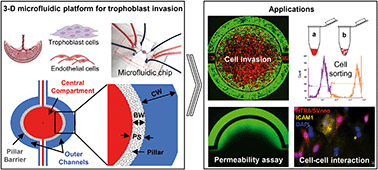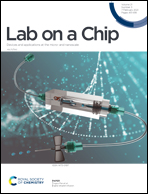A 3-dimensional microfluidic platform for modeling human extravillous trophoblast invasion and toxicological screening†
Abstract
Placental trophoblast cells invasion into the maternal uterus is an essential and complex event in the formation of the maternal–fetal interface. Commonly used two-dimensional (2D) cell invasion tools do not accurately represent the in vivo cell invasion microenvironment. Three-dimensional (3D) silicone polymer polydimethylsiloxane (PDMS) microfluidic platforms are an emerging technology in developing organ-on-a-chip models. Here, we present a placenta-on-a-chip platform that enables the evaluation of trophoblast invasion with intraluminal flow within an engineered PDMS 3D microfluidic chip. This platform reproduces key elements of the placental microenvironment, including endothelial and trophoblast cells, layered with an extracellular matrix, and incorporates dynamic medium flow while allowing for real-time monitoring, imaging, evaluation of trophoblast cell invasion, and heterocellular cell-to-cell interactions. Coupled with fluorescent cell tagging and flow cytometry, this platform also allows collection of the invasive cells. This will help our understanding of pathways that regulate trophoblast cell invasion and may prove important for toxicological screening of exposures that interfere with invasiveness in a complex organ such as the placenta.



 Please wait while we load your content...
Please wait while we load your content...